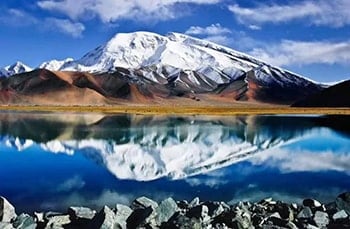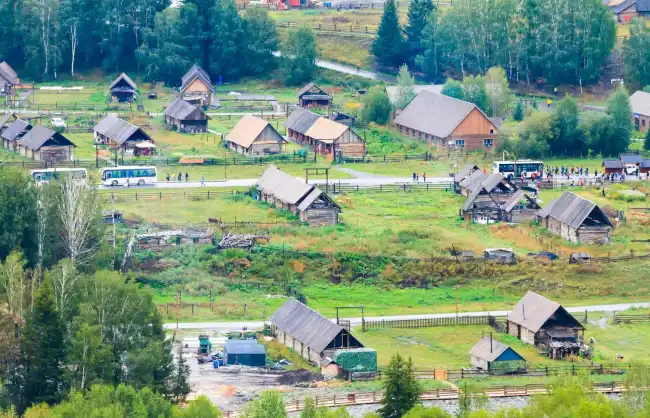Xinjiang Travel Guide: Things to Know before You Go
The western end of the Silk Road in China, Xinjiang Uyghur Autonomous Region is where west and east, ancient and modern culture collide in unique ways. It is the largest and westernmost province-level division of China, being teemed with exotic culture, spectacular landscapes, and stunning relics.
This vast land is home to diverse landscapes. It is always confident to wow worldwide nature and adventure seekers with its pristine lakes, towering snow-capped mountains, fascinating Yardang landforms and desert scenery, and expansive grasslands.
As home to multiple ethnic groups, such as Han, Uyghur, Kazakh, and more, Xinjiang travel is also rich in exotic and diverse ethnic cultures. It exudes a unique cultural charm, which can be experienced through the bustling International Grand Bazaar, tasty foods, unique architecture, and maze-like alleys in ancient towns, sacred mosques, etc.
Many people also travel to Xinjiang to trace the ancient Silk Road heritage. It boasts many ancient Silk Road hubs, where grotto murals, ruins, heritages, and crafts can vividly show you the former glory and culture exchange.
In this Xinjiang Travel Guide, we will delve into this captivating land, exploring its top places and attractions, things to do, weather, best time to go, accommodation, transportation, etc.

- Chinese name: 新疆 xinjiang
- Location: Northwest China
- Capital city: Urumqi
- Area: 1,664,900 square kilometers
- Population: 25.98 million people (in 2023)
Why Visit Xinjiang
Amazing Natural Landscapes and Sceneries in Xinjiang
With three mountain ranges (the Altai Mountains, Tianshan Mountains, and the Kunlun Mountains) surrounding two basins (Tarim Basin and Junggar Basin), the topography of Xinjiang endowed this vast land with a myriad of fascinating natural landscapes. You can expect dazzling mountain lakes like Sayram Lake, Karakul Lake, Heavenly Lake, unique Yardang landforms like Urho Ghost City, wild desert basins, idyllic Hemu Village, and verdant grasslands like Narati, Tangbula Grassland, and picturesque valleys with blooming flowers.
A Bulk of Historical Silk Road Sites and Heritages in Xinjiang
Half of the ancient China Silk Road was located in Xinjiang, making it a must-visit for anyone who wants an in-depth Silk Road tour experience.
Along the ancient route, western merchants brought their products and culture to Xinjiang, leaving a brilliant culture mix and numerous heritages in Xinjing. Nowadays, tourists can still get a rare chance to look into the thousands of years old relics and ruins in Xinjiang, say Jiaohe Ruins, beacon towers, ancient tombs, Buddhist grottoes (Kizil Caves, Bezeklik Thousand Buddha Caves), Gaochang Ancient Cities, Kashgar Ancient Town, etc.
Exotic Ethnic Culture and Customs in Xinjiang
Xinjiang is home to over 50 ethnic groups, including Han, Uygur, Kazak, Hui, Mongolian, etc., a harmonious region with the most ethnic groups in China. The many ethnic groups have their own customs, culture, arts, and lifestyles, so, that’s no surprise that a Xinjiang trip will be a fantastic experience with various ethnic culture and custom experiences.
Tasty Xinjiang Foods and Fruits
Given the close connection between local food and local people, tasting Xinjiang food will surely enhance your travel experience and cultural understanding of Xinjiang. Xinjiang cuisine is predominantly halal, dominating meat dishes. Top representatives include Dapanji, roasted and boiled mutton, etc. Additionally, Xinjiang is also rich in juicy and sweet fruits and melons, and Turpan, Hami, and Korla are the recommended places to feast your stomach.
Top Xinjiang Travel Destinations
- Urumqi: The capital city and a perfect starting point for a Xinjiang trip, International Grand Bazaar offers a glimpse into local market culture, near to the Heavenly Lake of Tianshan Mountains.
- Kashgar: Preserves the essence of Uyghur culture. Maze-like neighborhood filled with Uyghur architecture, markets, century-old teahouses, Id Kah Mosque, etc.
- Turpan: Desert meets oasis: Flaming Mountains, lush Grape Valley, Karez irrigation system. Explore tales of ancient kingdoms at Jiaohe Ruins and Gaochang Ruins.
- Altay (Kanas): Top natural wonders in Northern Xinjiang: Kanas Lake embraced by lush larch forests, otherworldly autumn scenery, traditional wooden cabins of Tuva people, world-class skiing experience in winter.
- Ili: A world of rolling grasslands, wildflowers, and alpine lakes: Nalati Grassland, Sayram Lake, lavender fields of Huocheng, and Apricot Blossom Valley in spring.
- Hotan: Known for jade and oasis culture. the journey along the desert highway through the Taklamakan Desert reveals breathtaking landscapes of shifting sands and oasis towns.
- Kuqa: The end of Duku Highway. Discover the earliest Buddhist murals in China at Kizil Thousand Buddha Caves. Explore Mar-like red rock formations at Tianshan Grand Canyon. Visit the Kuqu Grand Mosque and the ruins of the Subashi Temple.
Naraty Grassland
As one of the world’s four largest grasslands, Naraty Grassland offers not only vast meadows, but also spruce forests, snow mountains, and winding rivers. You can visit local Kazakh villages and experience their nomadic life.
Kizil Caves
The earliest carved large-scale Buddhist grotto complex along the Silk Road, Kizil Caves can be date back to about the 3rd to 8th-9th centuries CE, and is recognized as the cultural symbol of the ancient Kucha Kingdom. Murals in the caves blend influences from Chinese, Uyghur, Tibetan, and ancient Kucha cultures, and are distinguished by their "diamond-shaped composition."
Top Things to Do in Xinjiang
Besides visiting the above-mentioned top attractions in Xinjiang, you can also join the following activities for a deeper exploration and understanding of this mysterious land.
Drive on Highways in Taklamakan Desert to Admire Wild Landscapes
Taklamakan means “can get in, can’t get out” in Uyghur. As the largest desert in China and the second largest drifting desert in the world, it expands 1,000 km from east to west, and 400 km from north to south. The vast scale and changable weather make it once a challenge to venture deep into the desert.
Now, thanks to the construction of several highways through its hinterlands, traveling into the desert has become a scenic, and rewarding journey. Luntai-Minfeng Highway (522km, runs north to south) and Ala’er-Hotan Highway (424 km) are the two most popular ones. Each of them will offer you golden dunes of different shapes, wind-sculpted sand ridges, poplar forests, stunning yardang formations, oases, etc.
- Xinjiang Toursincluding Taklamakan Desert:
12 Days Urumqi-Turpan-Korla-Kuqa-Hotan-Kashgar Silk Road Adventure
Visit the Tashkurgan Stone City and Experience Tajik Culture
Perched on a hilltop on the Pamir Plateau, the Stone Fortress of Tashkurgan can date back to the Han Dynasty, and was once the royal capital of the Puli Kingdom. It is at the intersection of the southern and central Silk Road, standing as the last stop for caravans before they crossed the Pamir Plateau.
This ancient stone city boasts a history of over 2,000 years, and was built by the Tajik ancestors using large stones. Though much of the fortress has worn down, there are still remaining walls, watchtowers, and ancient Buddhist niches showing its former grandeur.
The Tajik folk village at the foot of the Stone City is home to the only European ethnic group in China. The Tajik people still preserve their unique customs and like to invite visitors to their homes to taste yak yogurt and almond tea.
Silk Road tours including Tashkurgan Stone City:
Admire the Tarim Populus Euphratica Forest in the Autumn
Tarim Poplar Forest Park is the largest natural poplar forest reserve in Xinjiang. As most of China’s poplars are in Xinjiang, and most of Xinjiang’s poplars thrive along the Tarim River. More than just a collection of ancient trees, the Tarim Poplar Forest is a mesmerizing fusion of diverse landscapes, including golden desert poplars standing in the vast sands, poplars reflected in tranquil riverbanks, and the weathered ancient poplars in twisted forms.
Visitors can hop on a sightseeing train to journey through the park, hop off and take photos at certain scenic stops. Mid-October to early November is the best time to visit the forest, as they transform into a sea of flames, with their golden leaves shimmering against the vast desert backdrop.
Taste Various Xinjiang Foods
Traveling to Xinjiang is also a gastronomic journey through the flavors of different ethnic groups. Xinjiang foods is dominated by Uyghur, Kazakh, and Hui cuisines, with influences from influences from Central Asia and China’s heartland. The must-try classics on a Xinjiang tour include unparalleled lamb, freshly baked Naan, big plate chicken, pilaf, etc.
Related Reading: How to Plan a Xinjiang Tour
Xinjiang Weather – Best Times to Visit Xinjiang
Xinjiang enjoys a cold semi-arid climate and is best to be visited in Autumn. In general, the best months to visit Xinjiang are August, September, and October.
Xinjiang is divided into the northern part and southern part by the Tianshan Mountains, and the two parts enjoy very different climates due to the influence of Tianshan Mountain on climate and the different geography in each part.

Northern Xinjiang features basin geography and vast grasslands, showing different charming scenes in different seasons. June to August are the best months to appreciate blooming wildflowers and verdant grassland in Ili. September will entertain you with golden autumn scenery, Kanas in September is at its most beautiful, and in Hemu Village, the cooking smoke curling up among the golden yellow birch forest is just like a huge oil painting.
Southern Xinjiang features a large area of barren desert and brilliant culture. April to October are all great months to visit Kashgar, Hetian, Aksu, etc. when the temperature is at its most comfortable.
Xinjiang Transportation – How to Get to Xinjiang & Travel Around Xinjiang
It is convenient to get to Xinjiang by flight or bullet train.
Get to Xinjiang by Air
Xinjiang has the most civil aviation airports in China, and can be reached by air from nearly 80 cities in China. Most people choose to arrive at Urumqi Diwopu International Airport as it has the most flights to major cities in China. Kashgar Airport with many domestic flight routes is also popular.
Get to Xinjiang by Bullet Train
The Lanzhou Urumqi High-Speed Railway makes it convenient to travel along the Silk Road from Gansu to Xinjiang. The railway starts from Lanzhou in Gansu and finally arrives in Urumqi, passing through several important ancient Silk Road hubs, including Zhangye, Jiayuguan, Dunhuang, and Turpan.
Travel Around Xinjiang
Given the vast area of Xinjiang, there is a long distance between different attractions. Renting a car or joining in a tour with a private vehicle and driver are the most popular methods to explore Xinjiang.
If you need to travel between two cities that are far apart, the many provincial flights will provide great convenience. For example, you can efficiently transfer between Urumqi and Kashgar, Urumqi and Kanas by air.
Xinjiang Accommodation – Where to Stay in Xinjiang
In Xinjiang, it is easy to find hotels with different star ratings according to your interest and budget.
In the most popular tourist cities like Urumqi, Kashgar, and Turpan, a wide range of excellent hotels from local featured ones to international chains are available for your choice.
While in some remote areas like Kanas, Hemu Village, Sayram Lake, etc., please note that the accommodation may be limited and the facilities were roughly basic.
Where to Stay in Urumqi
Urumqi’s downtown area is most recommended for the convenient transportation, short distance to popular sites like Xinjiang Museum and Xinjiang International Grand Bazaar.
Hotels around Urumqi International Airport are about 16 km from the downtown area, recommended if you arrive in Urumqi late or need to catch an early flight the next morning.
Around the Heavenly Lake Scenic Area, there are no places for accommodation.
Where to Stay in Kashgar
You can stay in both Kashgar downtown and Kashgar Old City, most hotels are 3-star or local homestays that are decorated in Uyghur style.
Where to Stay in Turpan
Accommodating at Turpan downtown area should be the first choice thanks to the convenient transportation and many hotels of different standards.
Popular attractions in Turpan like Flaming Mountains, Grape Valley, and Bezeklik Thousand Buddha Caves, are all near the downtown area and can be reached within 1 hour by car.
Is It Safe to Travel in Xinjiang?
Yes, it is safe to travel to Xinjiang, for either group tours or solo travel, and it is also safe to take public transportation in Xinjiang. Local Uyghur people are incredibly friendly. You will never feel threatened or unsafe while in Xinjiang, though you might meet constant police checks.
Just take the common precautions like in anywhere else in the world:
- Avoid talking about sensitive religion or political issues;
- Most local Uyghur people believe in Islam, please respect locals’ customs and culture.
- Dress modestly, especially when visiting mosques (females should wear long-sleeve clothes.);
- Don’t try to bargain if you are not planning to purchase;
- Listen carefully to your guide’s advice when visiting a local family, mosque, or taking pictures in some attractions.
Top Xinjiang Tours
- Best 10 Days Northern Xinjiang Scenic Tour
- 9 Days Southern Xinjiang Adventure Tour
- 5 Days Best Urumqi-Kashgar Tour by Flight
- 12 Days Xinjiang Silk Road Tour for Nature and Culture Tracing
You can also contact our travel consultant to tailor-make your own Xinjiang tour.








